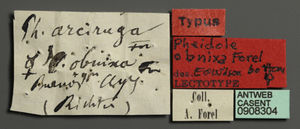Pheidole obnixa
| Pheidole obnixa | |
|---|---|

| |
| Scientific classification | |
| Kingdom: | Animalia |
| Phylum: | Arthropoda |
| Class: | Insecta |
| Order: | Hymenoptera |
| Family: | Formicidae |
| Subfamily: | Myrmicinae |
| Tribe: | Attini |
| Genus: | Pheidole |
| Species: | P. obnixa |
| Binomial name | |
| Pheidole obnixa Forel, 1912 | |
Nothing is known about the biology of obnixa .
Identification
See the description in the nomenclature section.
Keys including this Species
Distribution
Buenos Aires, Córdoba, and Santa Fé, in Argentina. (Wilson 2003)
Latitudinal Distribution Pattern
Latitudinal Range: -31.632389° to -31.632389°.
| North Temperate |
North Subtropical |
Tropical | South Subtropical |
South Temperate |
- Source: AntMaps
Distribution based on Regional Taxon Lists
Neotropical Region: Argentina (type locality).
Distribution based on AntMaps
Distribution based on AntWeb specimens
Check data from AntWeb
Countries Occupied
| Number of countries occupied by this species based on AntWiki Regional Taxon Lists. In general, fewer countries occupied indicates a narrower range, while more countries indicates a more widespread species. |

|
Estimated Abundance
| Relative abundance based on number of AntMaps records per species (this species within the purple bar). Fewer records (to the left) indicates a less abundant/encountered species while more records (to the right) indicates more abundant/encountered species. |

|
Biology
Castes
Worker
Minor
Images from AntWeb
   
| |
| Lectotype of Pheidole obnixa. Worker. Specimen code casent0908304. Photographer Will Ericson, uploaded by California Academy of Sciences. | Owned by MHNG, Geneva, Switzerland. |
Nomenclature
The following information is derived from Barry Bolton's Online Catalogue of the Ants of the World.
- obnixa. Pheidole arciruga r. obnixa Forel, 1912f: 236 (w.) ARGENTINA. Forel, 1913l: 231 (s.q.). Combination in P. (Elasmopheidole): Bruch, 1914: 219. Raised to species: Santschi, 1925e: 157. See also: Wilson, 2003: 138.
Unless otherwise noted the text for the remainder of this section is reported from the publication that includes the original description.
Description
From Wilson (2003): Similar to Pheidole aberrans, Pheidole cavifrons and Pheidole longior, distinguished as follows.
Major: head comparatively short (Head Length/Head Width 1.2 mm, the same as aberrans, much shorter than cavifrons and longior); pronotal dorsum covered by widely spaced longitudinal carinulae, with those near the midline curving outward toward the rear; occiput covered by transverse carinulae; humerus, mesonotal convexity, and propodeal spines well developed; a low lobe present on profile of postpetiolar venter. Minor: pronotum covered by semicircular carinulae.
MEASUREMENTS (mm) Paralectotype major (Rosario de Santa Fé, Argentina): HW 1.20, HL 1.34, SL 0.50, EL 0.14, PW 0.60. Lectotype minor (Buenos Aires): HW 0.52, HL 0.54, SL 0.40, EL 0.08, PW 0.34.
COLOR Major: concolorous light brown.
Minor: mesosomal waist yellowish brown, head and gaster light brown.
Figure. Upper: paralectotype, major (Rosario de Santa Fé, Argentina; only tentatively associated with lectotype minor). Lower: lectotype, minor (Buenos Aires, Argentina). Scale bars = 1 mm.
Type Material
Buenos Aires, Argentina. Musee d'Histoire Naturelle Genève - as reported in Wilson (2003)
Etymology
L obnixa, steadfast, resolute, allusion unknown. (Wilson 2003)
References
- Bruch, C. 1914. Catálogo sistemático de los formícidos argentinos. Rev. Mus. La Plata 19: 211-234 (page 219, Combination in P. (Elasmopheidole))
- Forel, A. 1912g. Formicides néotropiques. Part III. 3me sous-famille Myrmicinae (suite). Genres Cremastogaster et Pheidole. Mém. Soc. Entomol. Belg. 19: 211-237 (page 236, worker described)
- Forel, A. 1913m. Fourmis d'Argentine, du Brésil, du Guatémala & de Cuba reçues de M. M. Bruch, Prof. v. Ihering, Mlle Baez, M. Peper et M. Rovereto. Bull. Soc. Vaudoise Sci. Nat. 49: 203-250 (page 231, soldier, queen described)
- Santschi, F. 1925e. Fourmis des provinces argentines de Santa Fe, Catamarca, Santa Cruz, Córdoba et Los Andes. Comun. Mus. Nac. Hist. Nat. "Bernardino Rivadavia" 2: 149-168 (page 157, raised to species)
- Wilson, E. O. 2003. Pheidole in the New World: A dominant, hyperdiverse ant genus. Harvard University Press, Cambridge, MA. (page 138, fig. major, minor described)
References based on Global Ant Biodiversity Informatics
- Bruch C. 1914. Catálogo sistemático de los formícidos argentinos. Revista del Museo de La Plata 19: 211-234.
- Cuezzo, F. 1998. Formicidae. Chapter 42 in Morrone J.J., and S. Coscaron (dirs) Biodiversidad de artropodos argentinos: una perspectiva biotaxonomica Ediciones Sur, La Plata. Pages 452-462.
- Forel A. 1913. Fourmis d'Argentine, du Brésil, du Guatémala & de Cuba reçues de M. M. Bruch, Prof. v. Ihering, Mlle Baez, M. Peper et M. Rovereto. Bulletin de la Société Vaudoise des Sciences Naturelles. 49: 203-250.
- Gallardo A. 1932. El subgénero Elasmopheidole en la República Argentina (Himenopteros Formicidos). Revista Chilena de Historia Natural 36: 178-182.
- Kempf, W.W. 1972. Catalago abreviado das formigas da regiao Neotropical (Hym. Formicidae) Studia Entomologica 15(1-4).
- Vittar, F. 2008. Hormigas (Hymenoptera: Formicidae) de la Mesopotamia Argentina. INSUGEO Miscelania 17(2):447-466
- Vittar, F., and F. Cuezzo. "Hormigas (Hymenoptera: Formicidae) de la provincia de Santa Fe, Argentina." Revista de la Sociedad Entomológica Argentina (versión On-line ISSN 1851-7471) 67, no. 1-2 (2008).



